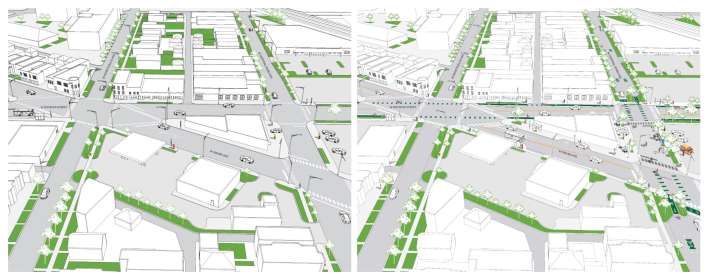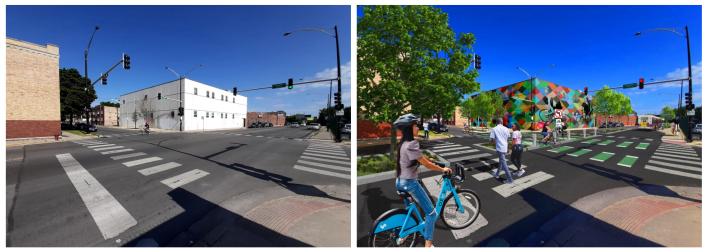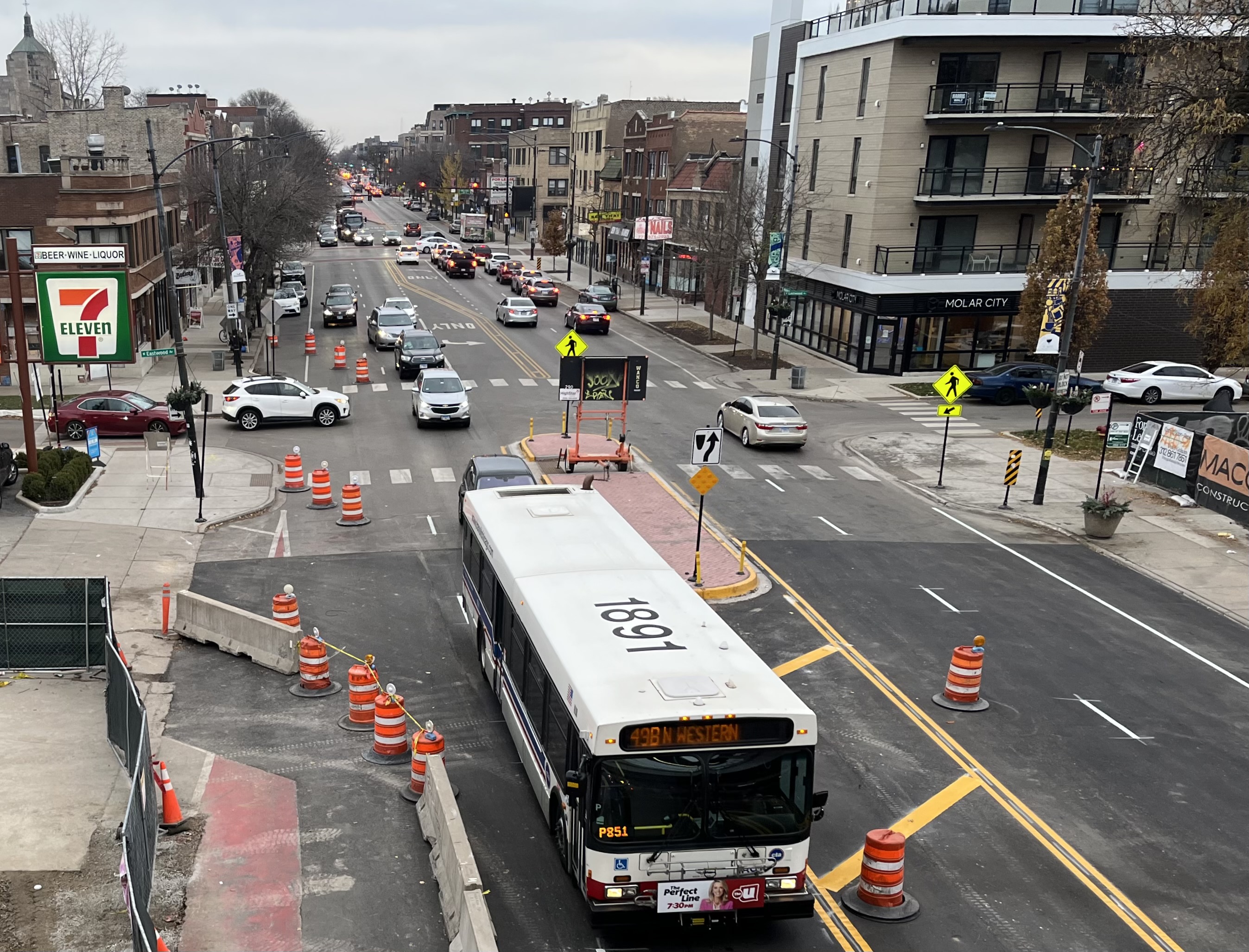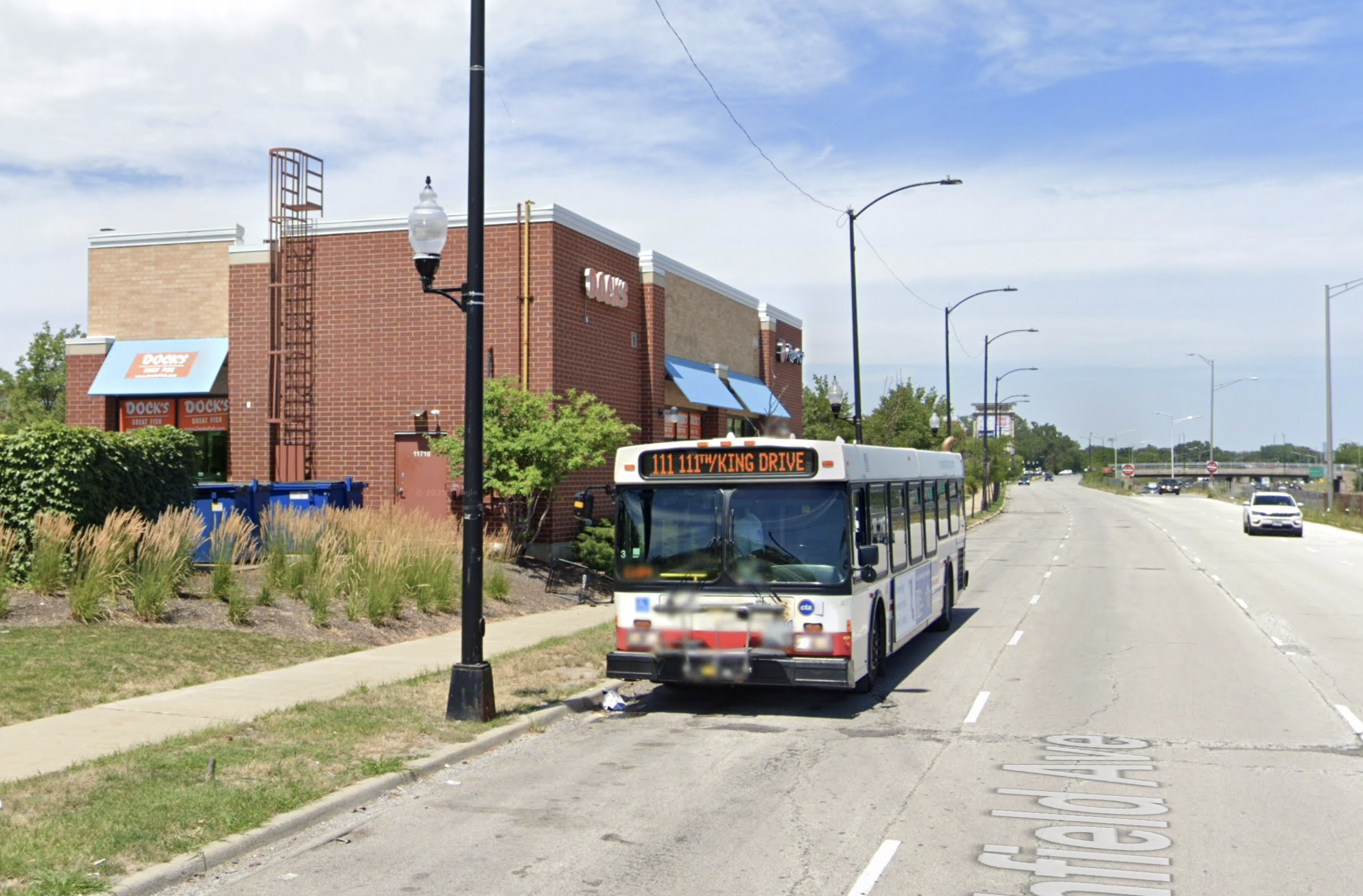Cities around the country and around the world have responded to the transportation challenges posed by the COVID-19 pandemic by repurposing travel lanes to make room for safe, efficient, socially-distanced transit, walking, and biking. Doing so will help prevent a dangerous spike in driving as workplaces and other destinations reopen.
So far, Chicago has lagged way behind peer cities in this department. Aside from a handful of Slow Streets, plus the revenue-driven Cafe Streets outdoor dining program, which has the side benefit of creating more space for walking, for most of the pandemic the Lori Lightfoot administration has done little to create more space for sustainable modes.
There was some good news in that department last week when the city of Chicago announced plans for pop-up bus lanes on 79th Street and Chicago Avenue. But with Chicagoland traffic almost back up to pre-pandemic levels already, while transit use is still heavily depressed, it's clear more has been done.
On Friday representatives from local sustainability advocacy groups the Active Transportation Alliance and the Metropolitan Planning Council, joined by Lyft, the Divvy bike-share concessionaire, issued a call to arms on that front in the form of a Sun-Times op-ed. They called for federal funds to help local transit agencies maintain service levels, plus the creation of a "network of resilient streets with extra space for walking, bicycling, and buses."
"Our roads cannot handle the 'carpocalypse' that will result if public transit becomes unreliable just as travel increases to pre-COVID levels, not to mention the additional noise, air pollution, and traffic injuries," the advocates and Lyft wrote. They noted that Chicago's car-centric transportation system disproportionately impacts Black and Latino residents, pointing out, for example, that almost half of all people to die from traffic violence in our city are African-American. They added that the coronavirus crisis has exacerbated our city's transportation inequalities because residents of color are more likely than whites to work essential jobs that require showing up in person.
The op-ed noted that walking, biking, and transit promote public health through physical activity and improved air quality. Meanwhile, people who live in areas with poor air quality are more likely to die of COVID.
The advocates and the ride-hail company pointed to a recent Lyft-bankrolled Sam Schwartz Engineering analysis of Chicago's Division Street corridor that found that as many as 7,000 people who normally commute in the morning by transit may avoid public transportation as the city reopens. If no changes are made to encourage sustainable transportation, only 19 percent of those straphangers, or 1,700 people, are projected to switch to walking or biking, with virtually all of the other 5,300 predicted to switch to car-based modes.
On the other hand, the study estimates, if upgrades like pedestrian improvements and protected bike lanes are added, the Division corridor could carry 14,000 walking and biking trips daily, helping to save 38,000 vehicle miles traveled per day. That could make a huge difference in reducing crashes, congestion, and pollution.

"Local governments can’t do this on their own, especially with budgets decimated by the economic slow-down, the op-ed states. "In addition to emergency transit funding and relief for state and local governments, Congress should increase long-term funding for walking, cycling and transit as part of a new multi-year transportation bill currently being negotiated."
The advocates and Lyft also note that Illinois' new capital bill includes a $50 million annual fund for walking and biking infrastructure. "With support at all levels of government, the Chicago area can enter the post-COVID era with a more resilient, equitable and sustainable transportation system."
More info on the Division Street corridor study
The Division study is part of Lyft's Resilient Streets Initiative campaign, which hired Schwartz and the design firm Street Plans to work with local advocacy groups to propose new layouts for corridors in various U.S. cities that would encourage sustainable transportation use, and predict what the outcomes would be for VMT, equity, and air quality.
Obviously, there's some irony here in that Lyft's main bread-and-butter, ride-hail, was a major source of congestion in cities before the pandemic greatly decreased demand for the service.
The Chicago study included new proposed designs for the complex Division/Central Park/Monticello/Grand intersection, as well as the Palmer/Pulaski junction, informed by community design charrettes, including representatives of the North River Commission, the Center for Neighborhood Technology, Six Corners Association, West Town Bikes, and Think Outside da Block, in addition to ATA and MPC. It looked at the entire eight-mile stretch of Division from Austin Avenue to Lake Michigan.
The study recommended the following changes to Division/Central Park/Monticello/Grand:
- Implement a “neighborhood greenway” design for North Central Avenue
- Add a pedestrian and bike median refuge that also serves as a northbound vehicular traffic diverter, preventing right turns movements for northbound motorists.
- Offer the same treatment to prevent right turns off of West Grand Avenue for southbound vehicular driving along Central Park Avenue.
- Add "super sharrow" markings, wayfinding and route branding signs, and "crossbike" markings to better align and make cyclists more visible as they cross West Division Street and West Grand Avenue.
- Add curbless “Shared Street” design on North Central Park Avenue between West Division and Grand Avenue.
- Add trees, landscaping such as benches, bike racks, and a Divvy station
- Widen sidewalks to support bus boarding and other pedestrian activity.
- Add curb-protected bike lanes along Division.
- Plant street trees and add other landscaping.
- Designate a ride-hail pick-up/drop-off spot.
- Add curb extensions for CTA bus boarding.

During the workshops, local advocates recommended looking at Palmer Street for biking improvements because it is identified as a Neighborhood Bike Route in Chicago's Streets for Cycling plan. Additionally, the stretch of Palmer between Cicero Avenue and Palmer Boulevard was supposed to become a Slow Street although due to political complications, that never actually happened. The following changes were recommended.
- Create a median safety island preventing east-west thru-vehicular movement along West Palmer but allow and shorten the crossing distance for people bicycling and walking across Pulaski; include green infrastructure to filter stormwater and beautify the corridor.
- Add a planted vehicular diverter limiting right-turn movements from southbound North Pulaski Road traffic onto westbound West Palmer Street; maintain east/south bound vehicular movements so as to not impede existing loading dock access.
- Introduce street art depiction of legendary Black bike racer Major Taylor.
- Add a bus bulb to ease boarding on the CTA’s #53 Cicero route

View the Division Street corridor study here.
To help secure more federal funding for local transit, click here for ATA's form to send an email to your elected officials asking Congress to include additional money for sustainable transportation in the next COVID stimulus bill.






